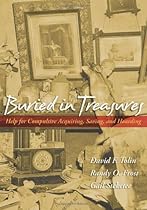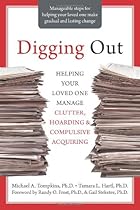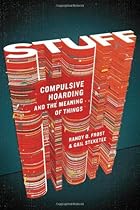COH-Library sales of these books about our parent’s disorder generate a small commission that help to keep us online. Thank you for your support!
The Secret Lives of Hoarders: True Stories of Tackling Extreme Clutter
By Matt Paxton, Phaedra Hise
Amazon Description:
On the front lines with extreme hoarders
The Secret Lives of Hoarders is much more than harrowing tales of attacking the ugliest, dirtiest, an d most shocking hoarding cases in the country. It is a behind-the-scenes look at this hidden epidemic- what it means, how to recognize it before it gets out of hand, and how to deal with it.
Through his work with hundreds of clients in the worst circumstances- from the giant “rat’s nest” that hid more than $13,000 in cash to a vast cache of cartoon pornography to twenty-five years’ worth of unopened mail-Matt Paxton has learned to understand this disorder and his clients’ impulses to collect, to speak the hoarders’ language, and to reach out to them with compassion and concern while avoiding criticism and judgment. Most important, he guides compulsive hoarders successfully through every step of the clean-up and healing process.
The Secret Lives of Hoarders is an engrossing and sometimes unsettling look at extreme clutter but one that helps hoarders, their families, and their friends to find meaning in the chaos.
STUFF: Compulsive Hoarding and the Meaning of Things
By Randy O. Frost, Gail Steketee
What possesses someone to save every scrap of paper that’s ever come into his home? What compulsions drive a woman like Irene, whose hoarding cost her her marriage? Or Ralph, whose imagined uses for castoff items like leaky old buckets almost lost him his house?
Randy Frost and Gail Steketee were the first to study hoarding when they began their work a decade ago; they expected to find a few sufferers but ended up treating hundreds of patients and fielding thousands of calls from the families of others. Now they explore the compulsion through a series of compelling case studies in the vein of Oliver Sacks. With vivid portraits that show us the traits by which you can identify a hoarderpiles on sofas and beds that make the furniture useless, houses that can be navigated only by following small paths called goat trails, vast piles of paper that the hoarders “churn” but never discard, even collections of animals and garbageFrost and Steketee illuminate the pull that possessions exert on all of us. Whether we’re savers, collectors, or compulsive cleaners, very few of us are in fact free of the impulses that drive hoarders to the extremes in which they live. For all of us with complicated relationships to our things, Stuff answers the question of what happens when our stuff starts to own us.

Buried in Treasures: Help for Compulsive Acquiring, Saving, and Hoarding
By David F. Tolin, Randy O. Frost, Gail Steketee
Buried in Treasures outlines a scientifically-based and effective program for helping compulsive hoarders dig their way out of the clutter and chaos of their homes.
Discover the reasons for your problems with acquiring, saving, and hoarding, and learn new ways of thinking about your possessions so you can accurately identify those things you really need and those you can do without. Learn to recognize the “bad guys” that maintain your hoarding behavior and meet the “good guys” who will motivate you and put you on the path to change.
The first book that ever came out about Compulsive Hoarding:
 Overcoming Compulsive Hoarding:
Overcoming Compulsive Hoarding:
Why You Save & How You Can Stop
By Fugen Neziroglu, Jerome, Ph.D. Bubrick, Jose A. Yaryura-Tobias
This book, the first ever written for savers and their families, provides an overview of compulsive hoarding and how it relates to obsessive-compulsive disorder. It discusses hoarding broadly, offering readers perspectives on the physical, behavioral, and value-oriented aspects of the condition. Readers can use its assessment tools to help decide why they or their loved one hoards. Skill-building exercises help readers determine how to beat the hoarding problem by addressing issues that often underlie compulsive saving. Even though this is fundamentally a self-help book, it contains a frank discussion about the need for professional help in some hoarding cases, how to find it, and what medications have been proven effective for savers.
 Digging Out: Helping Your Loved One Manage Clutter, Hoarding, and Compulsive Acquiring
Digging Out: Helping Your Loved One Manage Clutter, Hoarding, and Compulsive Acquiring
By Michael A. Tompkins, Tamara L. Hartl
Many people who hoard understand the extent of their problem and are open to help. This book is not for them. Digging Out is for the concerned and frustrated friends and family members of people who do not fully accept the magnitude of their hoarding problem and refuse help from others. If you have a friend or loved one with a hoarding problem and are seeking a way to guide him or her to a healthier, safer way of life, this book is for you.
In Digging Out, you will find a complete guide to helping your loved one with a hoarding problem live safely and comfortably in his or her home or apartment. Included are realistic harm reduction strategies that you can use to help your loved one manage health and safety hazards, avoid eviction, and motivate him or her to make long-term lifestyle changes. You’ll learn how to handle a roommate or spouse with a hoarding problem, identify and work through special considerations that may arise when the person who hoards is frail and elderly, and receive guidance for healing strained relationships between people who hoard and their friends and family. Take heart. With this book as a guide, you can help your loved one live more comfortably and safely, salvage your damaged relationship, and restore your peace of mind.
Therapists Guide for Compulsive Hoarding. Chapter 1. Review.
Written by the developers of this groundbreaking treatment, this manual is the first to present an empirically supported and effective CBT program for treating compulsive hoarding and acquiring. This guide gives clinicians the information to understand hoarding and proven tools to help clients overcome their compulsive behaviors. It teaches individuals how to recognize errors in thinking and uses both imagined and real exposures to teach them the skills they need to manage their problem. Home visits by the clinician are a part of the treatment, as well as consultations with other professionals who might assist if necessary. Homework exercises include behavioral experiments to test personal beliefs about possessions, developing an organization plan and filing system, and sorting and organizing items room-by-room.
Designed to be used in conjunction with the corresponding workbook, this therapist guide provides numerous assessment and intervention forms to help clients use the methods described in this program. Complete with case examples and strategies for dealing with problems, this user-friendly guide is a dependable resource that no clinician can do without.
Video:
Information About Compulsive Hoarding
In this video series Dr. Reinardy discusses the common characteristics and contributing variables found in hoarding behavior and demonstrates techniques that can be used to effectively declutter a home. The information and strategies can be utilized by individuals who hoard, their family members, and professionals who work with this population.→More books about understanding hoarding
Have you read any of these books and have a review you would like to add below?

